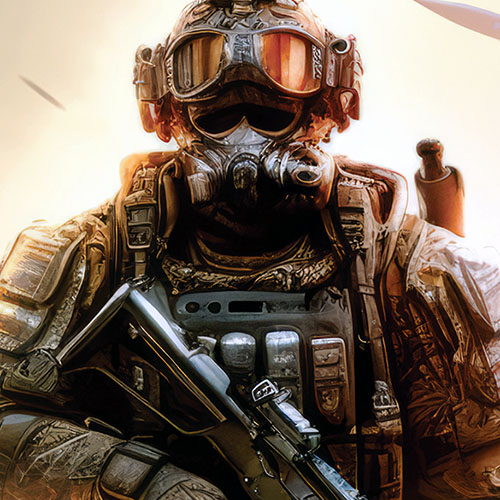Twenty Years of Forever Warring on the Internet…
Tweets DO Fail Us Now
At age 36, I’m part of the last American generation that remembers life before the internet, before social media. Try explaining to the youngsters what dial-up was, the importance of a good (and cryptic) AOL away message, or how it took two hours to download one naked photo of Jenny McCarthy. Times were tough.
Over the last two decades, the internet’s changed substantially, and so has the way we use it. Social media’s been at the vanguard of this evolution. From Friendster to Blogger to Snapchat to whatever newfangled site teenagers adopt tomorrow, the platforms we use to communicate and present ourselves on say a lot about us as a society, and as people. Through it all, the American military’s been at war on the far edges of the world, fighting and killing and trying, as best they can, to stay connected with the homeland and their loved ones.
The trajectory of social media is also a trajectory of the forever war. To see the connection between the two, look no further than how the conceptual projects conjured up in Silicon Valley garages get utilized in dire, spartan conditions by soldiers and Marines. The military brass didn’t always like social media, sometimes they even tried to ban it, but (cue Jeff Goldblum-from-Jurassic Park-voice), technology finds a way.
American war and social media, strange bedfellows for sure, yet they have been intertwined for 20 years now. Here’s a tracing of that history.
Fall 2001-Winter 2002: 9/11 happens. Early conspiracy theories fester on chat boards. America invades Afghanistan. Wall Street Journal reporter Daniel Pearl is kidnapped in Pakistan, and beheaded nine days later. Video of his execution spreads across social media like wildfire. A new age of psychological warfare is upon us.
2002: The Afghan Wireless Communications Company is awarded the first Global System for Mobile license and contract in Afghanistan. The fall of the Taliban government means many things, including real internet access. This does not come close to ending the war, but one can presume it does bring the dick pic to Afghanistan, which is not nothing.
2004: Military blogs, aka “milblogs,” begin to emerge from bases across Afghanistan and Iraq, bringing to readers raw, unvarnished combat stories. One of the most popular, “My War: Killing Time in Iraq” by infantryman Colby Buzzell, details the author’s experiences during the Battle of Mosul. It subsequently gets shut down for operational security violations.
The Pentagon initially responds to the rise in unapproved social media postings by service members by shutting off access to popular blogging sites and YouTube. This does not have the intended effect of controlling information.
2006: Milblogs become mil books. A slew of blogs-turned-books get published, including Buzzell’s My War, and collected anthologies like Doonesbury’s The Sandbox and Blackfive’s The Blog of War: Front-Line Dispatches From Soldiers in Iraq and Afghanistan. The irony is that in ten years, no one will read either books or blogs (wokka wokka).
June 2008: Yours truly gets his blog, “Kaboom: A Soldier’s War Journal,” shut down during a tour in Iraq. Don’t make fun of your battalion commander on the internet, kids, it will get back to him! Your intrepid hero gets yelled at a lot, but that’s pretty much it — partially because a lieutenant colonel at the Pentagon argues that crushing me for blogging is the exact wrong lesson to take away from social media. Is the Green Machine actually learning about twenty-first-century communications?
January 2011: The U.S. Army issues an official social media handbook. I’m sure every soldier out there has read it cover to cover! Given more and more bureaucratic oversight (official and otherwise), service members begin to transition away from public blogs and identifiable Facebook pages to anonymous message boards and Twitter accounts when sharing the real dope. Alas, this scenario is not covered in the handbook.
May 2011: Navy SEALs ice Osama bin Laden, then drop him into the ocean for the sharks to feast upon. Word spreads through Twitter before President Obama officially announces it to the globe. “America, Fuck Yeah!” gets uttered everywhere in earnest. Celebrators gather at the White House. This is the closest thing to a Victory Day parade we’ll ever get, and for one dark spring night, things seem okay again.
January 2012: Video of U.S. Marines urinating on corpses of Taliban fighters in Afghanistan goes viral. The video — a few months old at the time of its release — causes immediate blowback, and is cited as the reason for a number of “green on blue” attacks by Afghan soldiers on Coalition service members. One of the Marines involved dies a few years later of a prescription drug overdose. He’s buried with honors at Arlington, as his military career was much more than that short clip shown the world over.
April 2012: After years of being a horrific urban legend, a military widow learns of her husband’s death in Afghanistan, not from an official next-of-kin visit, but from a Facebook post.
June 2014: At the peak of the ISIS “caliphate” in the Middle East, ISIS social media extremists taunt First Lady Michelle Obama with a meme, using a doctored photo of her holding a “#BringBack Our Humvee” sign. Beyond the trolling, the meme is a reminder that American arms and war machines sometimes end up in the hands of the enemy, a stark complication in an era of local partnerships and coalition-building.
September 2017-2018: Fourteen years after his death in Afghanistan, former NFL star and Army Ranger Pat Tillman becomes a meme. Conservatives angry about Colin Kaepernick’s anthem protest turn to the square-jawed likeness of Tillman for comfort — a bizarre projection, given Tillman’s own iconoclastic worldview and nontraditional politics. President Trump gets involved, using Tillman’s memory and the meme to attack Kaepernick. Tillman’s widow issues a thoughtful statement asking that her fallen husband’s memory not be politicized; given that it’s over 20 words, however, it’s unlikely the members bothered to read it.
Matt Gallagher is a U.S. Army veteran and the author of the Iraq memoir“Kaboom”and the novel“Youngblood.” His next book,“Empire City,”is an alternate history and will be published in April.




















